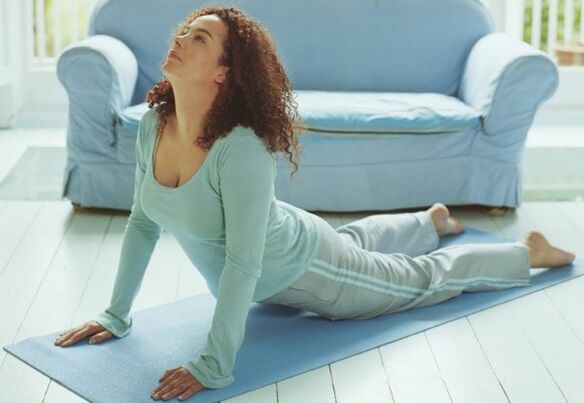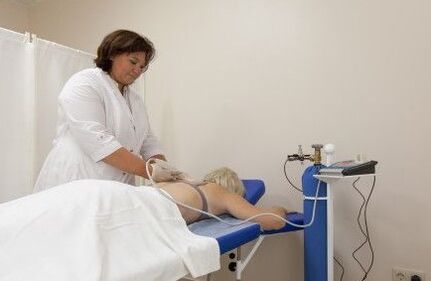Osteochondrosis of the cervical spine is a fairly common disease in which dystrophic changes occur in cartilage tissue, discs between the vertebrae and the bone base in them. This pathology develops in many people over the age of 30. The symptoms of cervical osteochondrosis are different, making it quite difficult to diagnose the disease and choose the right treatment.

Factors provoking the appearance of the disease
Cervical osteochondrosis can develop under the influence of the following factors:
- overweight;
- sedentary work, inaction;
- Previous spinal injuries;
- mental disorders, nervous excessive, stress;
- poor physical training;
- curvature of the spine, scoliosis, incorrect posture;
- in the wrong body condition that has become a habit;
- tension in the neck, back during operation;
- slope at the genetic level;
- unusual physical stress on the body, increased activity;
- Inside meals.
The cervical spine is exposed to increased loads whose cervical muscles try to balance the above source during influence. It provokes the appearance of muscle spasms, which causes the blood to be transported throughout the body. As a result, the formation of anatomical damage is noted.
The degree of osteochondrosis
In the development of cervical osteochondrosis, the discs between the vertebrae are weakened, which causes discs, vertebral structure, and the tissue of the cervical joint changes. The first degree of the disease occurs almost asymptomatically, as cartilage changes are just starting. In this case, the person complains of appearance:
- headache;
- neck discomfort, hands, shoulders;
- minor restrictions on neck motor activity;
- temporary reduction in visual function;
- Reducing sensitivity in the collar area.
The second stage is sometimes accompanied by a slight appearance of spinal hernia, as well as narrowing of the cracks between the vertebrae. Due to nerve receptor violations, there is a feeling of pain in the movement process. Against the background of the second degree disease, the patient notes the appearance:
- pain syndrome in the neck, cut with head movements;
- loss of skin sensitivity in the hand and shoulder area;
- reduction of visual function;
- ringing ears;
- numbness in the face and neck;
- imperfections in the hands;
- Shooting pain that goes on the shoulder blade;
- Disorders of sleep function.

It is very difficult to treat osteochondrosis of the third degree of cervical region. During this time, hernia develops, the spine is deformed, changes in position, and the dislocation ridge elements are observed. This stage of the disease is added to:
- pronounced neck pain, myocardium, collar area;
- Lack of skin sensitivity in the head, arms and shoulders;
- Hand paralysis;
- lack of tendon reflexes;
- hernia formation in cervical vertebrae.
The exacerbation of signs is noted in the fourth (last) stage process.
Symptoms
Signs of disease in the neck are significantly different from the symptoms of osteochondrosis in another area of the vertebra column.Because the cervical vertebrae are close, the nerve roots and spinal cord are compressed.This leads to the appearance of the following signs:
- The pain syndrome is localized in the neck, pockets, shoulders, arms and legs. Joining nerve receptors, uncomfortable appearance in the shoulder area, back of the head, hands begin to rebuild. Due to the spasm, the cervical muscles disrupt blood circulation.
- The occurrence of weakness in the upper limbs is noted, associated with damage to the root functionality, which contributes to the inclusion of motor nerve, which restores muscle tissue in the hands.
- The upper limbs are rebuilt due to reduced sensitivity, root violations with sensitive nerve endings.
- When you turn your head, you can also hear crispness. This is due to damage to the small joints of the cervical region - a decrease in intervertebral disc level.
- The patient complains of insufficient endurance, the appearance of fatigue, dizziness, and coordination disorders. Due to the movement of the spinal elements, the vertebral artery is squeezed out. Therefore, blood circulation worsens, causing blood supply to the occipital section and brain.
- The appearance of vision problems, loss of sensitivity in language is noted.
Symptoms of cervical osteochondrosis in women are no different from marks in men. Women who have reached 45 years of age and older who have been diagnosed with such a disease in a dream note numbness and tingling in the upper limbs.
What are the danger of osteochondrosis of the cervical region
The disease can harm the body as a whole. The neck is located in a significant amount of arteries, nerve receptors, blood vessels through which the brain is supplied. If even a minor disease occurs, they are squeezed out.It provokes the problems of cerebral blood supply problems.As a result, migraine formation, heart rhythm disorders, respiratory and visual function problems are observed, and coordination and attention are also disrupted.
The following diseases are possible on the background of osteochondrosis of the neck:
- pathologies in the brain;
- arterial vascular syndrome in the spine;
- Spinal stroke.
The most serious complication is the death of the patient, which can occur by squeezing the spinal canal. Symptoms and treatment of cervical osteochondrosis are associated with the stage of the disease.
Therapeutic activities of cervical osteochondrosis
Osteochondrosis of the cervical spine is prescribed, regardless of the patient's sexual sex. Treatment occurs in several stages:
- Removal of painful manifestations.
- Prevention of swelling.
- Blood circulation to normal.
- Muscle strengthening at the back, abdominal press, chest.
- Improvement of nutritional quality and tissue spine regeneration.
If even signs of insignificant disease are found, you should consult a specialist. Using such a pathology, an integrated approach is used, requiring a surgeon, neuropathologist, physiotherapist and manual therapist.
For therapeutic purposes, taking into account cervical osteochondrosis, medication, physiotherapeutic treatment, collar area massage and physiotherapy exercises as it is quite effective in this condition.
Medication
When determining osteochondrosis of the neck, they are prescribed:
- preparations to prevent muscle spasms;
- vitamin tools to improve metabolic processes in the central nervous system;
- Medicines from the NSAIDs to relieve pain, prevent inflammation and swelling;
- The joints of the joints, by promoting cartilage restoration, prevent disorders between the vertebrae.
- Medicines that are beneficial for improving the diet of the affected nerve tissue, regulating blood flow to the brain.
First aid for exacerbating cervical osteochondrosis
Sometimes if the pain syndrome becomes intolerable, but it is not possible to see a doctor, experts recommend taking painkillers. You can resort to the help of the "pepper patch" to relieve the pain, but this tool only makes it easier for a short time.The patch will help warm the affected area and relieve pain for a while.It is recommended to use herbal infusions for 3-4 days to get rid of swelling.
But it is worth considering that it will not work to recover from cervical osteochondrosis using the following methods. These methods help to cope with the signs of the disease for only a short time. You will need to contact a specialist to prescribe complete therapy.
Physiotherapeutic procedures
In the framework of complex treatment to enhance the effect, the use of:
- Electrophoresis - Analgesic ions are entered the affected area due to the effects of electric current. Novocaine or lidocaine is usually used during the procedure.
- Laser therapy - it has an anti -inflammatory effect, improves blood circulation with the effects of light.
- Magnetic therapy - helps to get rid of edema in tissues, has an analgesic effect.
- Ultrasound - Helps improve metabolism, anesthesia, removes the inflammatory process in the affected area.

Medical Physical Education
Also with cervical osteochondrosis, therapeutic exercises will help improve well. It is worth noting that exercises should not be accompanied by pain or discomfort. Exercise Complex:
- We are lying on our stomach and resting on the floor. The back should be smooth and the head and body are lifted. We are delaying in this position for about 2 minutes, then returning to the starting position. We do 2-3 repetitions.
- We sink on the floor, leaning on our backs, out of our bodies. First, turn your heads to the right, then right, trying to touch the floor with your ear. We do the exercise 6-7 times in each direction.
- We sit on the floor. We breathe and lean our head forward, trying to touch the chest with it. On the exhalation, we throw our heads back. Exercise should be repeated 10-15 times.
- We sit on the floor, press our hands on the forehead and at the same time lower our heads. Exercise should be done for about 30 seconds, repeated 2-3 times.
- Smooth, slowly, we turn our heads so as not to cause dizziness. In case the head began to dizzy, the exercise should be stopped. It is necessary to make rotation 10 times left, then to the right.
Home treatment
Such therapy can only be used as part of a comprehensive treatment prescribed by your doctor.At home you can use folk remedies, physiotherapy and massage.
With cervical osteochondrosis, you can use the following recipes:
- Put the horseradish leaf on the sludge and attached with a bandage or fabric. The sheet should be poured with hot water and then cooled to room temperature. Such a bandage is placed at bedtime and left until morning.
- Complete the potatoes and mix with honey in equal proportions. Apply to set the compress every 7 days.
- To weaken the pain, warming will help with mustard, sandbag, pepper patch, etc.

It is advisable to seek medical advice before using all the remedies.
Massage
Healing massage can be done at home. You should start a massive healthy body area, gradually moving to the affected area. The massage complex should be selected taking into account the individual characteristics of the patient, the degree of neglect of the disease. Massage should be done by the patient by placing it horizontally on the floor. You have to put your hands on your forehead and my chin is raised in your chest. The neck muscles must be relaxed.
Massage is done as follows:
- First we massage the collar area with caressing movements.
- Then go to compression. To do this, put your hands on your neck and move around your spine. This technique can also be used by massaging the shoulders.
- We rub it to warm the neck muscles. This will help the body relax, improve blood circulation. When using circular movements, you should move from the skull along the spine.
- The last movement is the vibration that is done due to rocking and shocks.
Preventive activities
To prevent the development of cervical osteochondrosis, recommended:
- Sports (the ideal option is to visit the pool).
- Enter products enriched with calcium and magnesium in the diet.
- Wash several times during the day, especially if it is busy at work.
- According to the requirements to replace the pillow (buy low) and mattress (you need quite difficult). Follow the neck in your dream: the neck should bend at least 15 degrees.
- Go a hot shower for at least 10 minutes throughout the day.
- People who do not do sports doctors recommend periodically visiting the yoga section.
- Do not engage in simulators as this can cause a good deterioration.


























































































